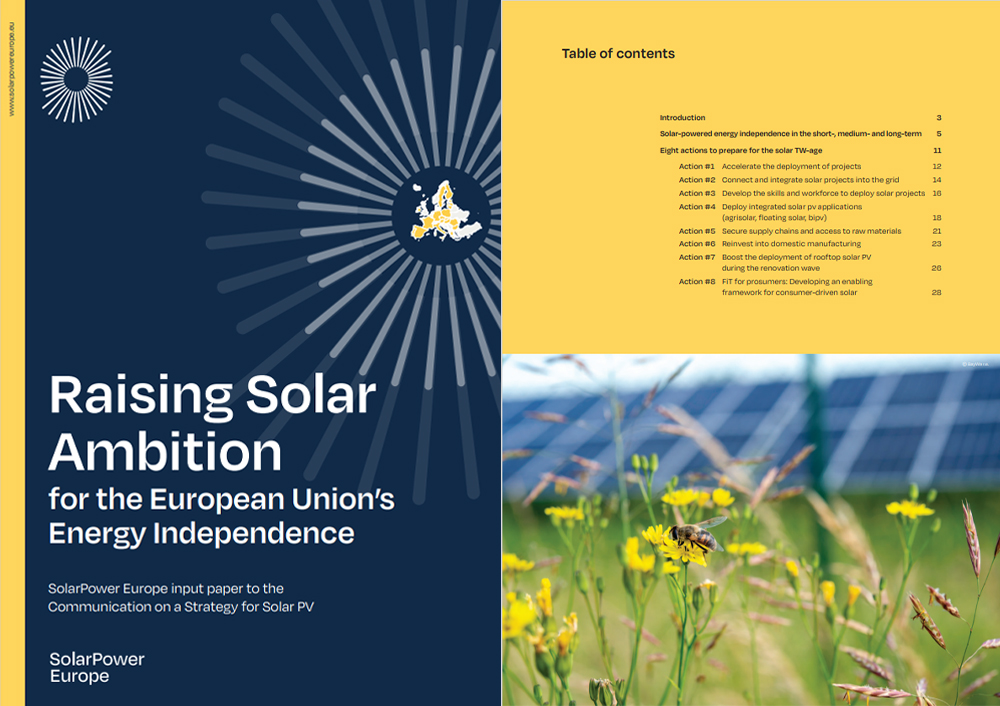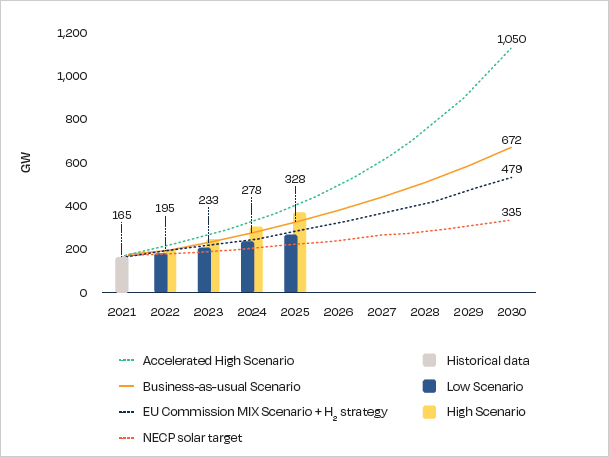PV column
energy
2022/04/01
Eight Actions to Solar-Power EU Energy Independence New Report
This report was released by SolarPower Europe on March 31, 2022. For details & download of this report, please visit the website of SolarPower Europe.

On March 31st the international solar community gathered in Brussels for the SolarPower Summit. In light of the unprovoked Russian war on Ukraine, the Summit publicly launched a landmark paper on the necessary, realistic, ambition for solar-powered EU energy independence.
Presented to EU Commissioner for Energy, Kadri Simson, by European solar CEOs during a roundtable exchange, ‘Raising Solar Ambition for the European Union’s Energy Independence’ acts as SolarPower Europe’s official response to the consultation for the upcoming EU Solar Strategy. This paper sets out exactly what solar power can deliver for the EU’s climate goals and energy security in the short-, medium-, and long-term (and what we need to get there).
In the short term, to support immediate divestment from Russian gas, and with the right framework for the rooftop segment, solar can deliver 39 GW* of additional EU energy capacity for the coming winter. This represents 23.3 GW of solar rooftops, and 15.7 GW of utility scale solar installations. SolarPower Europe is currently surveying the sector to understand what additional utility scale solar is possible if we are able to fast-track shovel-ready projects.

The real solar acceleration can happen in the medium-term. The current REPowerEU solar market 2030 projection of 525 GW falls short of the true potential of solar expansion, with industry pre-war, business-as-usual scenario predictions of 672 GW. With the Russian war on Ukraine, and the increasingly acute climate crisis, the paper presents an accelerated high scenario, foreseeing over 1 TW of total EU solar capacity by 2030, and details the eight actions that will build the necessary foundations for the European solar Terawatt age:
- Accelerate the deployment of projects
- Connect and integrate solar projects into the grid
- Develop the skills & workforce needed to deploy solar projects
- Deploy integrated solar PV applications
- Secure supply chains and access to raw materials
- Reinvest in domestic manufacturing
- Boost the deployment of rooftop solar PV during the renovation wave
- Develop an enabling framework for consumer-driven solar
Eight Actions to prepare for the solar terawatt age:
- Accelerate the deployment of projects
In the short-term, we can accelerate existing projects already in the pipeline to ensure completion by end of 2022, identify go-to areas for additional solar & storage projects, and set a clear EU-level target for 100 GW of solar PV deployment per year from 2025.
In the medium-term, we should develop scientific evidence & citizen awareness of the benefits of solar, share biodiversity best-practice among local stakeholders, launch structured dialogue between energy, environment and agriculture authorities, and through the JRC, map land available for solar plants. - Connect and integrate solar projects into the grid
In the short-term, we can suspend grid connection costs between 2022-24, develop a framework for grid-friendly solar projects (solar and storage, hybrid renewables), and launch a dedicated support program for such projects.
In the medium-term, we can reduce permitting process duration, increase the open data obligations from TSOs and DSOs on the grid structure, and develop an EU-level roadmap on grid modernisation and flexibility development, including at distributed level. - Develop the skills & workforce needed to deploy solar projects
In the short-term we can give clear signals to the electrical and mechanical installers industry by mandating solar panels on all rooftops and banning the installation of new gas and oil boilers.
In the medium-term we can launch a Skills Initiative for the solar PV industrial ecosystem, as foreseen in the European Skills Agenda, including communication campaigns and structured co-operation between authorities, industry, and educators. An effective Solar Skills Initiative will include funding for training programs, the inclusion of solar in national apprenticeship programs, and targeted cooperation with EU neighboring states for skilled labor movement. - Deploy integrated solar PV applications
such as agrisolar, floating solar, and building-integrated PV.
In the medium-term we can create a flagship initiative on innovative PV deployment, gathering evidence on the benefits of floating PV and agrisolar, as well as a database of incidents, identify O&M solutions, create models for OPEX costs, define impacts on deliverability. We could also launch a BIPV Strategy as part of the Solar Industrial Strategy, building on the New European Bauhaus initiative. - Secure supply chains and access to raw materials
In the medium-term we should develop a comprehensive analysis of the raw materials needed in the solar PV industry, building on the preliminary work of the European Raw Materials Industry and ensuring an involvement of the industry. This exercise should focus in particular on silicon metal, silver, aluminum, and copper. - Reinvest in domestic manufacturing
In the short-term, like the Chips Fund, we should launch a €1 bn Solar Fund to leverage private investment. We should also set a target to close financing on shovel-ready projects within 6 months, define & implement sustainability criteria to create a level playing field among PV products, and eliminate EU trade barriers to facilitate access to necessary components and raw materials. - Boost the deployment of rooftop solar PV during the renovation wave
In the short-term we have the opportunity to launch an EU Solar Rooftop initiative to frontload investments into 23.3 GW of rooftop solar PV by the end of 2022, while easing State Aid approval procedures to allow member states to grant short term, ambitious public support for renovation and solar deployment.
In the medium-term we could develop a massive awareness-raising campaign on renovation and rooftop PV development, and an adequate regulatory framework, through the revision and the subsequent implementation of the EPBD and the REDII. - Fit for prosumers: Develop an enabling framework for consumer-driven solar
In the short-term we should ensure rooftop PV deployment is accompanied with the deployment of energy system management and local battery storage, to make rooftop PV prosumer-ready or flexibility-ready.
In the medium term, we could identify best practices in prosumer frameworks development and develop a forum for the sharing of such practices, define an action plan for the development of consumer solar PV solutions, and leverage the revision of NECPs to require national prosumer strategies from European governments.
Source: SolarPower Europe

